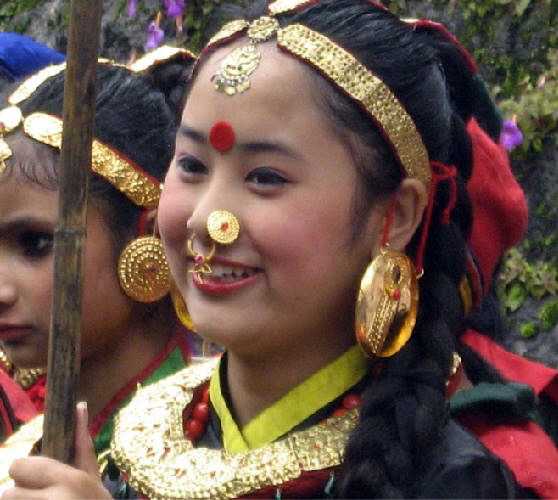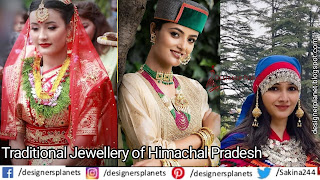Latest Blog Post
07 July
Traditional jewellery of Himachal Pradesh. Designerplanet
Traditional and Tribal Jewellery of Himachal Pradesh. Designerplanet
..
..Himachal Pradesh ethnic ornaments:
- Chamba Tribe
- Kinnaur Tribe:
..
..- 1. Chudamani:
- 2. Khul-kantaie:
..
..- 3. Chandra Malang: Chandra Malang
- 4. Chak ornament:
..
..- 5. Gokhru:
- 6. Chanderhar:
- 7. Kiry:
- 8. Toke:
..
..- 9. Pari:
- 10. Jhumkas:
Type Himachali Jhumkas:
- Singi:
- Clips:
..
..- Beenie Chakk:
- Phullu:
Most Popular Post >>>>
..
Popular Post >>
..
06 July
Complete Jewellery guide for Sikkim brides . Designerplanet
Complete Jewellery guide for Sikkim brides . Designerplanet
..
The Sikkimese wedding dress is similar to the royal dress and is called ‘bakhu’. The ‘bakhu’ is made of the finest silk and is made in a traditional, yet unique way. It is an Ensemble consisting of a loose blouse, skirt and belt to tighten the waist.Beautiful accessories accentuate the look of the wedding. Both couples wear beautiful traditional pure gold jewelry. Small and elegant jewelry is made that reflects the simple and elegant style. The concept of ‘White Marriage’ has also become very popular in Sikkim. Millions of people living in Sikkim follow this wedding tradition. Before that, the bride wore a wedding dress in bright and vibrant colors. But for now, only simple white dresses have been chosen that are similar to the beautiful wedding dresses of Christian brides in Sikkim. The gold jewelry was replaced by very delicate and modern dress jewelry. The bride prefers to wear simple and beautiful jewelry, which matches the dress, rather than traditional jewelry.
..
Traditional Jewelry of Sikkim from Head to Toe
What is Sikkimese jewelry?
Different Types of Traditional Sikkimese Jewelry
Traditional Jewellery of Sikkim:
..
..- Bhutia Tribe Traditional Jewellery:
- Yencho or Earrings
Bhutia women wear heavy gold-plated earrings, called Yencho. Yencho is an ornament for the ear and especially the earlobe.They go in the form of a wax and gold cast and are sometimes decorated with a turquoise or red coral in the center. They are usually flat and round.

- Khao
Khao is a traditional necklace worn by Bhutia women. It comes in two types - one made of gold and one with beads and semi -precious stones. Gold is torque-style, often chunky and heavy, and is designed to sit like a scarecrow on a woman’s neck.
- Phiru
Phiru is a pearl jewelry made into a necklace and is from Tibet. Sometimes they have a heavy silver or gold pendant as the centerpiece. For religious reasons, turquoise, red coral and Dzi beads have a heavy impact. Tibetans believe that turquoise plays an important role in giving its spiritual power to jewelry. Meanwhile, red coral is there to balance the spiritual impact of blue with turquoise. The local explanation for this balance is that the blue-green turquoise is worn by people with tired and bloody eyes.
Dzi beads are part of Tibetan as well as many Asian cultures using them as beads. They were originally made of agate and are found in Bhutia jewelry while avoiding the ‘evil eye’.
- Diu
Diu is the traditional bangle worn by Bhutia women. They are thick, heavy gold or silver, and sometimes decorated with semi-precious stones. Khalli Bhutia women love to be adorned with traditional jewelery and wear thick silver-plated shoes known as Khalli. These also have sometimes intricate carvings and shapes.
- Joko
Joko is the traditional ring of Bhutia women made of silver or gold. They vary in shape and form, but gold often has a turquoise or red coral in the center.
..
..
Diu, Khalli, and Joko made of silver are worn daily, while those made of gold are reserved for traditional festivals because Bhutias are proud of their gold. Men don’t have traditional jewelry but should wear the Shambo (traditional pine hat with fur) with their clothes on these important occasions.
Limbu ornaments The population of the Limbu community is of Sino-Tibetan descent and is one of the only ethnic groups that make up a large portion of the population of Sikkim. The women in this community are culturally and historically rich-not only because of the beautiful jewelry they possess but also because the Limbu community believes that race is transmitted matrilineally. Gold (samyang), silver (yuppa), glass (yuppa), coral or amber (ponche) and turquoise (mudhin) are the main ornaments. The primary influence of Limbu jewelry is nature. The jewelry they brought was as follows:
Headgear:
Samyanfung: It means ‘golden flower’ —which is real. It is a large round gold cap placed on the headpiece and usually has a red coral in the center. Samyangung is inspired by the sun and has been reflecting it since it was made on the head.
Sesephung:
The name means ‘bright flower’ and blossom. However, it was made in the shape of the moon and made of coral. Necklace: Yangyichi: It is also called Reiji and is a long necklace made of silver coins.
Namloyee: Also called Yogakpa, a silver necklace usually round or squaric in shape and similar to the Tibetan Ghau. The necklace is decorated with coral or turquoise.
Pongwari or Kantha: This necklace is made of soft fabric (plain red) and gold beads.
..
..
Earrings:
Nessey: A type of round ring made of heavy gold. It is made flat, and the most common type of spring is a coral or glass spring. Laskari: These are gold earrings that Limbu women wear daily on their ears. Its shape can vary from leaf to diamond. Yarling: Lotus -shaped earrings. In addition to these, two other important jewelry are the Swagep, a traditional gold ring, and the Hukpangi, a type of silver ring. Limbu women make many other accessories that are hard to name them all. Therefore, the few listed above are the only known and traditional ones. Like most Sikkimese men, Limbu men do not have traditional jewelry but real hats made of cloth called Paga - which makes them part of their personal clothing.
4. Other types of Sikkimese jewelery
As mentioned earlier, the Sikkim tribes have different costumes and ornaments - which makes it difficult to place them all in one category as a state. Therefore, we have discussed in detail only the three major tribes that originally settled.
In addition to them, Sikkim also has many ethnic groups of Nepali origin who speak the language. Some of them were also the first inhabitants of the land. This category will focus on jewelry from these groups and Sikkimese jewelry in particular.
Nepalese Tribe Traditional Jewellery:
..
....
....
..Tamang Jewelry
The Tamang community is a group of Sikkimese people from Tibet. Tamangs are an important part of Sikkim and make up 6.8% of the indigenous population of Sikkim. They have their own traditional clothes and jewelry. Tamang women have traditional star-shaped bracelets and mathi shoe laces. They also have chyap, gold necklaces, and nhabi mhar, gold earrings. They also wear gold -plated earrings called botil or alung.
Ghau Pendants
Ghau pendants are special necklaces of Tibetan origin that are actually decorated boxes to hold prayer scrolls! They are usually silver and have healing stones such as turquoise, lapis lazuli, and other corals. Buddhists keep many things like sacred herbs or relics of ancient gurus to remember them in these Ghau pendants.
..
..
Akor Earrings
Akor earrings are beautiful jewelry from Lhasa origin and are distinguished by their long length and end, which is a lotus flower. They were originally made of rope because of their weight and tied to headgear. Nowadays, you can easily see the beautiful and red coral reefs in Sikkim as they become part of the community.
..
..
Posted by Designerplanet at 06 July 0 comments
Labels: Complete Jewellery guide for Punjabi brides, designerplanet, sikkim bridal jewellery, sikkim brides, sikkim necklace for Women





























































